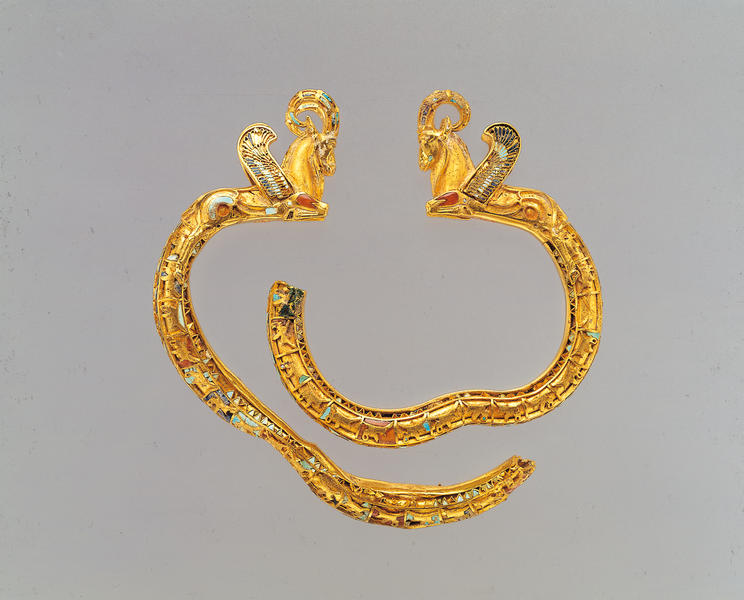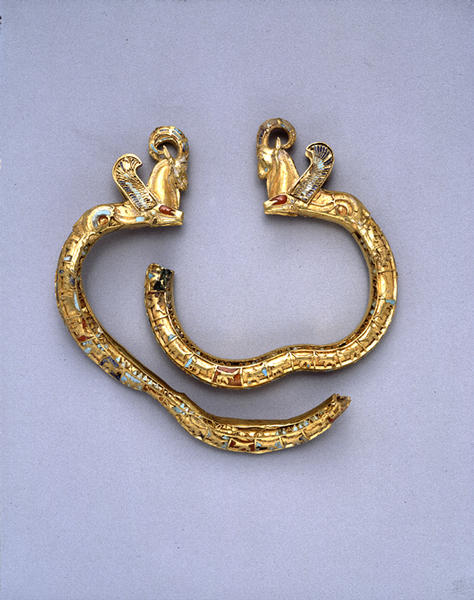有翼山羊装飾ブレスレット
- イラン
- アケメネス朝ペルシア後期
- 前6世紀中期-前4世紀
- H-11.2 W-11.1
腕輪本体を形作っている管には、細部にこだわった繊細なクロワゾネ細工によって、比類のないほど美しい装飾が施されている。中心的なモティーフは、先端部装飾として使われているヤギ科動物の縮小版である疾走する有翼のヤギ科動物が描かれた、等空間のパネルで構成されている。さらにこの文様は、三角形の連なる装飾帯で縁取られている。本来双方の腕輪とも、その本体の大部分に象嵌が施されていたものと考えられるが、現在ではほんの僅かしか残っていない。それでも容易に、鮮やかな色彩と豊かさを備えた腕輪を思い描くことができる。
先端部の装飾としてこの腕輪を飾っている想像上の動物は、本体のもつ装飾性とは対照的に彫刻的な力強さを示す役割を果たしている。これは本体とは別に鋳造されたものであるが、管部分の一部として作られているように見えるほど非常にたくみに接着されている。しかし同時に、視覚的には腕輪から跳び出そうとしているようにも見え、飛翔している最中をとらえられた2頭の動物の姿でその活力が表現されている。さらに、管部分の装飾文様の中で表現された疾走する小型のヤギ科動物が、その疾走の最終段階に至って2次元的な姿から跳び出し、丸彫り彫刻になったという印象を与える。先端を飾るこのヤギ科動物の解剖学的な細部は、アケメネス期の動物表現に典型的な様式化された方法で細かく表現されている。翼は別に取り付けられており、表現はより装飾的である。翼や角や胴体には本来象嵌が施されており、その一部が現在でも残っている
帝都建設の銘文
――そして此は私がスサに建てた宮殿。その資材は遠方より齎された。地面を地中の岩盤まで深く掘り下げた。土を取り除くと砂利が敷き詰められ、あるところは40キュビットあるいは20キュビットに達した。宮殿はこの砂利の上に建てられたのである。地中深く掘り、砂利を敷き詰め、泥煉瓦を作る―――――これら全ての作業はバビロニア人が行った。 杉材はレバノンの山からアッシリア人がバビロンまで運び、カリア人イオニア人がスサまで運んだ。シッソ材はガンダーラとカルマニアから、ラピス・ラズリ、カーネリアンの準貴石はソグディアナから。トルコ石はホラズム、銀とエボニー材はエジプト、壁の装飾はイオニア、象牙はエチオピア(クシュ)やインドそしてアラコジア、石柱はエラムのアビラドゥから運ばれた。石職人はイオニア人、リディア人。金細工師、象嵌細工師はメディア人、エジプト人。バビロニア人は煉瓦を焼き、メディア人、エジプト人は壁を装飾した。 このスサにすばらしいものを建てんとし、すばらしいものができた。願わくばアフラマツダの神が私、父ウィスタシュパそして我が同胞をみそなわし賜わんことを。
Walter Hintz/ The Elamite Version of the Record of Darius's Palace at Susa / 1950 Journal of Near Eastern Studies Vol.IX No.1
ペンダント付トルク
宝飾品ー腕輪、トルク、イヤリング、首飾、指輪印章他
有翼獣文様鉢
鴨装飾ブレスレット
鴨装飾ブレスレット
馬形リュトン
帝王闘争文様鉢
獅子頭形杯
獅子頭装飾ブレスレット
双獅子頭装飾ブレスレット
二頭の馬浮彫
ライオングリフィン形リュトン
メディア人従者浮彫
ブレスレット先端部
先端部の装飾としてこの腕輪を飾っている想像上の動物は、本体のもつ装飾性とは対照的に彫刻的な力強さを示す役割を果たしている。これは本体とは別に鋳造されたものであるが、管部分の一部として作られているように見えるほど非常にたくみに接着されている。しかし同時に、視覚的には腕輪から跳び出そうとしているようにも見え、飛翔している最中をとらえられた2頭の動物の姿でその活力が表現されている。さらに、管部分の装飾文様の中で表現された疾走する小型のヤギ科動物が、その疾走の最終段階に至って2次元的な姿から跳び出し、丸彫り彫刻になったという印象を与える。先端を飾るこのヤギ科動物の解剖学的な細部は、アケメネス期の動物表現に典型的な様式化された方法で細かく表現されている。翼は別に取り付けられており、表現はより装飾的である。翼や角や胴体には本来象嵌が施されており、その一部が現在でも残っている。
ブレスレット本体
腕輪本体を形作っている管には、細部にこだわった繊細なクロワゾネ細工によって、比類のないほど美しい装飾が施されている。中心的なモティーフは、先端部装飾として使われているヤギ科動物の縮小版である疾走する有翼のヤギ科動物が描かれた、等空間のパネルで構成されている。さらにこの文様は、三角形の連なる装飾帯で縁取られている。本来双方の腕輪とも、その本体の大部分に象嵌が施されていたものと考えられるが、現在ではほんの僅かしか残っていない。それでも容易に、鮮やかな色彩と豊かさを備えた腕輪を思い描くことができる。
Catalogue Entry
These two magnificent bracelets are said to have originally belonged with the torque (cat. no. 38) and should likewise be attributed to the late Achaemenid period.1 An association of these pieces is corroborated by stylistic and technical similarities.
The bracelets are composed of separately made gold elements, such as the caprid terminals, and hollow gold tubing, and they incorporate intricate cloisonn decoration and bands of triangular teeth, which are often seen on representations of Achaemenid robes.2 Each bracelet was originally adorned with two opposing winged caprids (goat- or sheep-like animals), a familiar motif of Achaemenid art, and which recurs in miniature on friezes on the circlets. Although heavily damaged, the surviving terminals still display the forceful and monumental court style of the Achaemenid Empire. Most of the ornamental contours of the muscles and other anatomical details such as the horns, eyes, or wings were once abundantly inlayed with colorful stones and glass paste, underlining the almost supernatural impression of the fabulous creatures.
The bracelets, with typical omega-shaped indentations (compare cat. no. 42) and complete animals instead of simple protomes (foreparts), follow the familiar typology of Achaemenid bracelets.3 The motif of running caprids was very popular in Achaemenid art. These creatures, in most cases winged, are all likelihood tragelaphoi, fabulous Persian caprids mentioned several times in Greek literature and compared by Plato with the sphinx of the Egyptians.4 They are depicted on items ranging from gems5 to precious vessels6 and even to the famous golden chariot that was constructed to carry Alexander's embalmed corpse from Babylon to the Mediterranean.7 Especially in connection with Alexander the Great, tragelaphoi seem to be linked to royal splendor, a concept that would correlate very well with the possibility that the torque and bracelets of this quality and iconography could have been royal gifts.
MP
1. As a comparison in style and technique see the well-known bracelets in London, British Museum 124017: Dalton 1969, pp. 32-34, no. 116, fig. 64, pl. 1; Pfrommer 1990b, pp. 121-24, 291, TA 116, fig. 16.3.
2. See for example Pfrommer 1997.
3. For comparative bracelets with complete animals of various kinds see Pfrommer 1990b, pp. 118-21. For the indentation see ibid., p. 99.
4. See, for example, Plato, Politeia IV.488 a; Athenaios XI.484 c (s.v. Labronia), XI.500 d, e (s.v. Tragelaphos). The sources will be discussed in another context.
5. As parallels for the running caprids on the circlets see [author TK 1908, p. 169, fig. 9.
6. See the famous pair of handles in Paris, Louvre AO 2748, and in Berlin, Staatliche Museen preu゜ischer Kulturbesitz, Antikenabteilung Misc. 8180: Amandry 1958, pp. 50-51, pls. 26.2; 27.2-.3; 28.4; Pfrommer 1990a, p. 198, fig. 4. Rhyton with protome of a tragelaphos from the "Seven Brother-kurgan IV," St. Petersburg, Hermitage SBr IV-3: Artamonow 1968, p. 35, pls. 117, 119.
7. Diodorus XVIII.26, 5.

